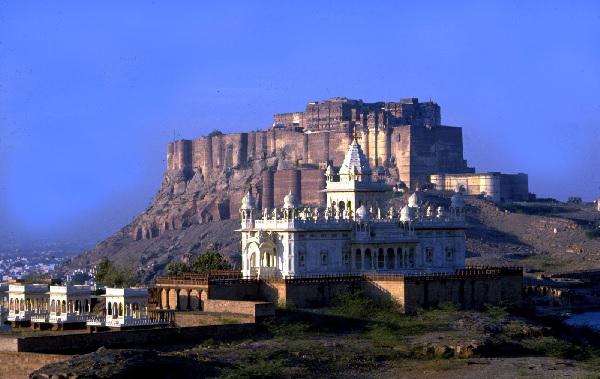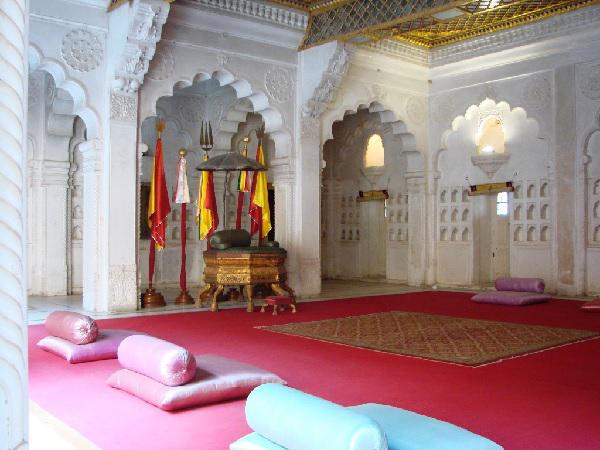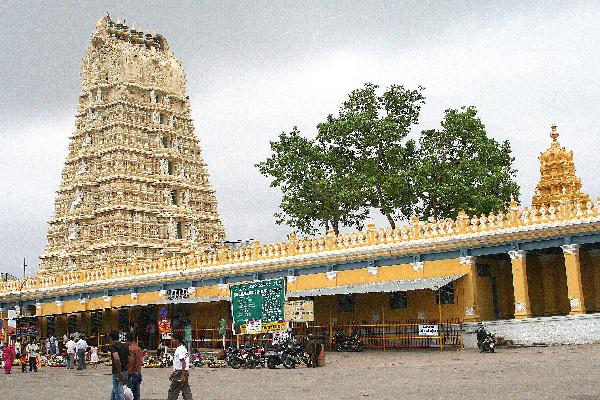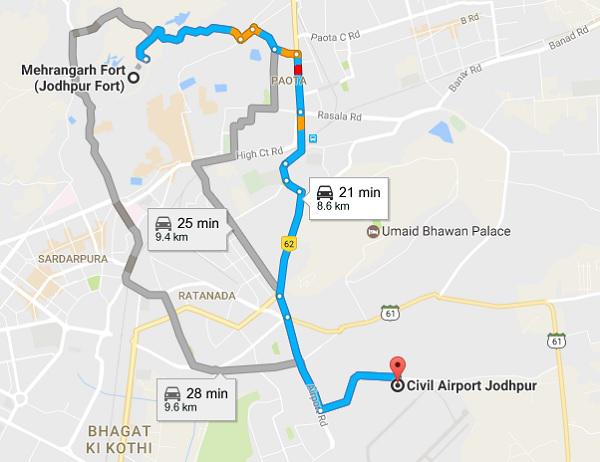Mehrangarh Fort - Quick Guide
Mehrangarh Fort - Overview
Maharaja Rao Jodha built the Mehrangarh Fort in 1460AD. The fort is considered as one of the biggest forts in India. One of its gate has the marks of the attack of cannons during the war with the army of Jaipur. The fort has many palaces, courtyards, temples, and other structures built by various Rajput rulers. Maharaja Man Singh built seven gates to remember the victory over the armies of Jaipur and Bikaner.

Jodhpur
Jodhpur is one of the largest cities of India and second largest of Rajasthan. Jodhpur is a historical city having many palaces, temples, forts, etc. Another name of the city is Surya Nagri or Sun City. The name is given due to bright and sunny weather throughout the year. Blue City is another title given to Jodhpur as many houses of the city are in blue color.

Visiting Hours
Mehrangarh Fort is opened for the public from 9am to 5pm. The fort is also opened on government holidays. It takes around one to three hours to visit the whole fort due to the presence of many structures inside it.
Tickets
Tourists have to pay an entry fee in order to visit the fort. For Indians, the cost of the ticket is Rs. 60 while for foreigners it is Rs. 400. Photography and video recording is also allowed and the tourists have to pay Rs. 100 for carrying still camera and Rs. 400 for video camera. The day of 12th May is celebrated as Jodhpur Foundation Day and entry in the fort is free on this day.
Best Time to Visit
Best time to visit Jodhpur is from October to March as the weather is pleasant. During the period of April to June, the weather of the city is hot and dry while during the period of July to September, the weather becomes hot and humid. There is low to moderate rainfall in the city.
Where to Stay?
There are more than 500 hotels where the people can stay. The hotels range from inexpensive budget hotels to expensive five-star hotels. Some of these hotels are as follows −
Mehrangarh Fort - History
Rao Jodha founded Jodhpur in 1459. Rao Jodha was the son of Maharaja Ram Mal and was the 15th Rathore ruler. Previously Rao Jodha ruled from the fort of Mandore but due to lack of security, he shifted his capital to Jodhpur. Rao Jodha laid the foundation of the fort on Bhaucheeria hill, 9km away from Mandore, with the help of Rao Nara.

The foundation of the fort was laid by Shri Karni Mata daughter of sage of Charan caste. As the main deity of the Rathores was Sun god so the fort was named as Mehrangarh where Mehran means Sun and Garh means fort.
The foundation of the fort was laid during the reign of Rao Jodha and was continued by many rulers. Maldeo ruled from 1531 to 1562 and built some structures inside the fort. Then Maharaja Ajit Singh who ruled from 1707 to 1724 built some structures. After him the next king who built the fort further was Maharaja Takhat Singh who ruled from 1843 to 1872. The last ruler was Maharaja Hanwant Singh who ruled from 1947 to 1952. Rao Jodha spent around Rs. nine lakhs to build the fort.
Death of various kings and royal people
There were many instances where either the kings or the royal people were killed. Jaswant Singh, who ruled from1873 to 1895, killed his mistress by throwing her out of the window. She was killed because she belonged to Jaswant Singh’s father and entered his room.
Maharaja Man Singh, who ruled from 1803 to 1843, killed his prime minister by throwing him who fall 400m down. Maharaja Ajit Singh, who ruled from 1678 to 1724 was killed by his son. Rao Ganga, who ruled from 1515 to 1532 fell down from the window and died while he was enjoying the breeze. It is also said that Maldeo pushed Rao Ganga from the window.
Legend regarding the Construction
In order to construct the fort, Rao Jodha forcefully shifted a sage named Cheeria Nath ji who cursed the king that the fort will suffer from draught. Rao Jodha pleased the hermit by making a temple and a house for him.
When the construction was started, it was destroyed the next day. This happened due to the curse of the sage. The king requested him to take back the curse but the hermit said that the words cannot be taken back. The hermit told that if he buries a man alive then the curse will be cancelled. So the king buried a man named Raja Ram Meghwal alive in the foundation and promised him that Rathores will look after his family. Due to this the current generation of Raja Ram Meghwal is living in Raja Ram Meghwal garden.
Blue Color of the fort and the city
It is believed that blue colour repels heat and mosquitoes and that’s the reason many portions of the fort are painted with blue colour. Tourists can view the city from the fort which also looks blue.

Previously, Jodhpur was known as Brahmapuri and only Brahmins could live in the city and paint their houses with blue colour.
Mehrangarh Fort - Gates
Mehrangarh Fort is located in the city of Jodhpur and is one of the magnificent forts of India. The fort has seven gates, a number of temples, palaces and many other structures. Here we will discuss about the gates present in the fort.
Jai Pol and Fateh Pol
Jai Pol is the main entrance to the fort. It was built by Maharaja Man Singh in 1808 to celebrate his win over Maharaja Jagat Singh of Jaipur. Fateh Pol or Victory Gate was built by Ajit Singh. He built the gate to remember the taking back of the fort from Mughals in 1707.

Lakhna Pol or Dedh Kanghra Pol and Amriti Pol
Lakhna Pol was constructed during the reign of Maharaja Maldeo. The pol was destroyed during the battle with the army of Jaipur in 1807. Amriti Pol was constructed by Maharaja Maldeo which leads to the original entrance of the fort. The original entrance was constructed by Rao Jodha. This entrance had a boulder with two holes. A log was inserted through each hole for providing barrier.

Loha Pol and Suraj Pol
Loha Pol was constructed in 15th century but its façade was constructed by Maharaja Maldeo in 16th century. The pol has the handprints of 15 queens who performed sati in which a wife or wives of a king burn themselves on funeral pyre of their husband.

Suraj Pol is considered as one of the oldest gates of the fort. There is a staircase at the entrance which leads to Moti Mahal.
Mehrangarh Fort - Palaces
Rao Jodha constructed many palaces inside the fort. Many features were added to the palaces by the rulers who came after Rao Jodha. The staircase of the palaces were narrow, the walls were decorated, and the windows have stained glasses. The height of the walls is 36m and width is 21m.
Sheesh Mahal
Sheesh Mahal of Mehrangarh Fort is different from the ones constructed by the Mughals in their forts. The palace has large and regular pieces of mirrors along with the figures of religious deities which are imposed over the mirror work. Due to the presence of the images of deities, the sheesh mahal was used as a private temple.

Phool Mahal
Phool Mahal was constructed by Abhay Singh who ruled from 1730 to 1750. The gold used during the construction of the palace was the war booty which the king got by defeating Sarbuland Khan, a governor of the Mughals.

Jaswant Singh II, who ruled between 1873 and 1895, added portraits, raga mala, and paintings to the palace. During the reign of Pratap Singh, wall paintings were made whose style was European.
Takhat Vilas
Maharaja Takhat Singh built the Takhat Vilas Palace. He was the last ruler who lived in the fort. Many traditional styles were used in order to decorate the palace. The walls of the palace have pictures which were painted with the help of wet plaster.

The ceilings include wood beams which are decorated with many pictures like Krishna Leela, Folk Dhola Maru etc. The floor is built in such a way that anybody can think that the floor is covered with carpet.
Moti Mahal
Moti Mahal or Pearl Palace is considered as the biggest palace of the fort. The palace was built during the reign of Maharaja Sur Singh. There is a big hall for private meetings. Five hidden balconies can be found from where the five queens of the king viewed the proceedings of the court.

The wooden ceiling of the palace is decorated with gold leaves and mirrors. The palace has the alabaster throne which can be found at one of the ends of a palace room. This is the same palace where coronation ceremony of many rulers starting from Rao Jodha was arranged. Sangar Choki or coronation seat was used during the ceremony.
Khabka Mahal
Khabka Mahal was the sleeping palace which has two rooms named Dipak Mahal and Chandan Mahal. The Dipak Mahal was constructed by the Prime Minister of Jodhpur. Chandan Mahal was the room where the king used to discuss the affairs of his kingdom with his ministers.
Jhanki Mahal
Jhanki Mahal was constructed adjacent to Khabka Mahal. The palace was built for the queens who looked outside world from the palace. The palace had latticed screens so that nobody could see them while they are seeing outside world. Purdah system was mandatory for the women who look outside. One of the features of this palace was the placement of mirrors.

Moti Vilas
Moti Vilas is a palace having carved lattice screens. If a person sees the palace from a distance, he will think that the screens are made with laces. There is a zenana court which was built using stones which were beautifully chiselled.
Sardar Vilas
The Sardar Vilas was built nearby Moti Vilas and is featured with woodwork. The woodwork done in the palace are plated with gold and its decoration was enhanced with ivory. A marble can also be seen here which the king got from the king of Kabul.
Umaid Vilas
Umaid Vilas is a palace which has got many paintings. It has the paintings of Maharaja Pratap Singh and Maharawal Jaswant Singh of Jaisalmer. The painting of Pratap Singh was painted by an artist named Amar Das. Tourists can also find pictures where the kings are playing holi with their wives.
Mehrangarh Fort - Temples
Many temples were constructed in the fort by different kings during their reign. Some of these temples are as follows −
The Chamunda Mataji Temple
Rao Jodha worshipped Durga Mata a lot so he brought her idol from Mandore, his previous kingdom. The idol was installed in the fort and became the kul devi of Parihar caste. Rao Jodha made her Isht Devi. The idol was destroyed during the mutiny of 1857. It was reinstalled by Takhat Singh who ruled from 1843 to 1873. The temple is visited now also by many devotees.

Nagnechiji Temple
Nagnechiji temple was the family temple of Rathores. It is located in the extreme right of the fort. Rao Dhuhad brought the idol of Nagnechiji to Marwar in 14th century. Later the idol was installed in the Mehrangarh fort.
Jaswant Thada Cenotaph
Jaswant Thada Cenotaph was built in 1899 where Raja Jaswant Singh is worshipped. It is said that the king had healing powers due to which people started to worship him after his death.

The cenotaph was built in the form of a temple and stones and marble were used in its construction. Due to sati tradition, the wives and concubines of Jaswant Singh are also buried here.
Mehrangarh Fort - Other Structures
Daulat Khana
Daulat Khana was built beneath the Phool Mahal during the Mughal period. These were the times when the Rathores had good relationships with the Mughals. Heavy locks and liquor bottles can still be found which were included in curios. The liquor bottles were wrapped in the wet clothes and warriors used to drink from them before fighting any battle.

The curios also included many other things like coin boxes, carpet weights, hookas, etc. There is also a silk tent in the Daulat Khana made up of red and gold brocade. This tent was made for emperor Aurungzeb which was later taken away from his son by Raja Jaswant Singh.
Sileh Khana
Sileh Khana or armoury is another gallery where weapons of all the periods can be seen. Rajputs took great care of their weapons as it was a warrior tribe. Tourists can find guns, maces, shields, swords and other types of weapons here. Khanda of Rao Jodha, sword of emperor Akbar and Timur can be found here.
Elephant Howdas
Elephants are the animals which were a part of battles as they can throw humans and animals or can trample them beneath their foot. The howdas were the seats made up of wood and decorated with gold and silver. These were tied on the back of the elephant where kings used to sit.

Palanquins
Palanquins, also known as palki, were mostly used by noble women for travelling and circumambulation. Small palkis were called doli were used to carry women due to the strict purdah system of the Rajputs.

The covers of the palkis were decorated beautifully. When a royal lady was carried in a palki, her relatives or elder Rajputs used to accompany her. Each palki carrier has a stick to support the palki.
How to Reach Mehrangarh Fort?
Jodhpur is one of the major and popular historical city which is visited by many tourists from India and abroad. The monuments which the tourists like to see are Mehrangarh Fort, Umaid Bhavan, Rai ka Bagh Palace and many others. Jodhpur is well-connected by many cities in India through air, rail, and road transport. The nearest international airports are Jaipur and Delhi. Distance of some of the major cities from Jodhpur is as follows −
Jodhpur to Jaipur
- By air – 282km
- By rail – 311km
- By road – 337km
Jodhpur to Ajmer
- By air – 171km
- By rail – 240km
- By road – 235km
Jodhpur to Bikaner
- By air – 165km
- By rail – 277km
- By road – 259km
Jodhpur to Jaisalmer
- By air – 205km
- By rail – 291km
- By road – 235km
Jodhpur to Delhi
- By air – 478km
- By rail – 612km
- By road – 586km
Jodhpur to Ahmedabad
- By rail – 456km
- By road – 460km
Jodhpur to Mumbai
- By air – 833km
- By rail – 912km
- By road – 1024km
Jodhpur to Bharatpur
- By rail – 497km
- By road – 568km
Jodhpur to Surat
- By rail – 686km
- By road – 727km
Jodhpur to Agra
- By air – 504km
- By rail – 554km
- By road – 600km

By Air
Jodhpur has domestic airport which is around 5km away from the city. Flights to Jaipur, Delhi, Udaipur, and Mumbai can be taken from here. The nearest international airport from Jodhpur is Sanganer Airport in Jaipur and Indira Gandhi International Airport in Delhi.

By Train
Jodhpur is connected to many major cities through train. There are direct trains to Kolkata, Delhi, Ahmedabad, Bangalore, Mumbai, Jammu and other places. No Rajdhani, Shatabdi Double Decker, or Garib Rath Express run from here but superfast and fast mail and express trains start, terminate, and pass through the city.

By Road
Jodhpur is well-connected to the nearby as well as cities in other states through road transport. Tourists can catch buses for their destination from Rai ka Bagh Bus Stand which is near to the Rai ka Bagh Railway Station. Besides these, tourists can also catch buses operated by public and private bus services. Another option to come to and go from Jodhpur is taxi which the tourists can hire from taxi operators.

Local Transport
In order to explore the city, tourists can use auto-rickshaws, cycle-rickshaws, and taxis. There is also an option of city buses but they have very low frequency. Before hiring an auto or cycle-rickshaw, the amount to be paid shall be decided to get rid of any discomfort after reaching the destination.
Mehrangarh Fort - Nearby Places
Besides Mehrangarh Fort, tourists can also visit other places in Jodhpur. There are many temples, gardens, palaces, and other places which the tourists can visit. Some of these places are as follows −
Udai Mandir
Udai Mandir is situated on a raised platform and can be entered through a magnificent gate which was built with sandstone. The temple is supported by more than 100 pillars. The Garbha Griha inside the temple is covered by a cloth and is surrounded by gold pots. The inner walls of the temples are painted with 84 yogasanas. Along with this, there are paintings of Nath Yogis.

Masuriya Hill Garden
Masuriya hill garden is located on Masuriya hill and is very popular. There is also a temple in the precincts of the garden where a local deity named Baba Ramdev is worshipped. As the garden is situated on a hill, tourists can have a good view of the city of Jodhpur.

Umaid Bhavan Palace
Umaid Bhavan Palace was known as Chittar Palace as the stones with which it was constructed were brought from Chittar hills. Maharaja Umaid Singh laid the foundation of the palace in 1929 and the construction was completed in 1943. The palace has 347 rooms. A part of the palace is used as a hotel which is taken up by Taj hotels.

There is also a museum inside the palace where things that were used during the period of Rajputs can be seen. The motive of the construction was to employ thousands of workers during the time of famine.
Kaylana Lake
Kaylana Lake is an artificial lake which is 8km away from Jodhpur. In 1872, the lake was created by the orders of Maharaja Pratap Singh. The total area of the lake is around 84km2. Previously the place had palaces and gardens which were destroyed to create the lake. The palaces and gardens were built by Bhim Singh and Takhat Singh who ruled Jodhpur before Pratap Singh.


























